My easy guide walks you through how to cook a turkey that’s golden, juicy, and ready in just a few hours. Roasting a whole turkey on Thanksgiving for the past 20+ years has taught me valuable lessons about how to roast the most flavorful, juiciest turkey. It all comes down to one very simple technique— rubbing seasoned butter all over the turkey and under the skin. It will produce the most golden, crispy skin and the juiciest meat that is packed with flavor.
This trick, plus all of my tested tips for prepping the turkey and how to tell exactly when it is done, will help you roast the perfect bird for your holiday meal!
A reader says: “I decided to cook my Turkey your way, and lo and behold, I thought it was the BEST tasting turkey I ever roasted. The butter under the skin created the crispiest dark bird, which we love, and the juiciest turkey.” ★★★★★
Table of Contents
- Key Ingredients
- How Many Pounds Of Turkey Do I Need Per Serving?
- How To Thaw And Prepare A Turkey Before Roasting
- Quick Roasting Guide Based On The Size Of Your Turkey
- How To Properly Check The Internal Temperature
- FAQs To Know Before You Start
- Pro Tips For Roasting The Perfect Turkey
- How To Roast A Turkey
- How To Carve And Serve Roasted Turkey
- How To Store And Use Leftovers
- More Thanksgiving Recipes To Try
Key Ingredients
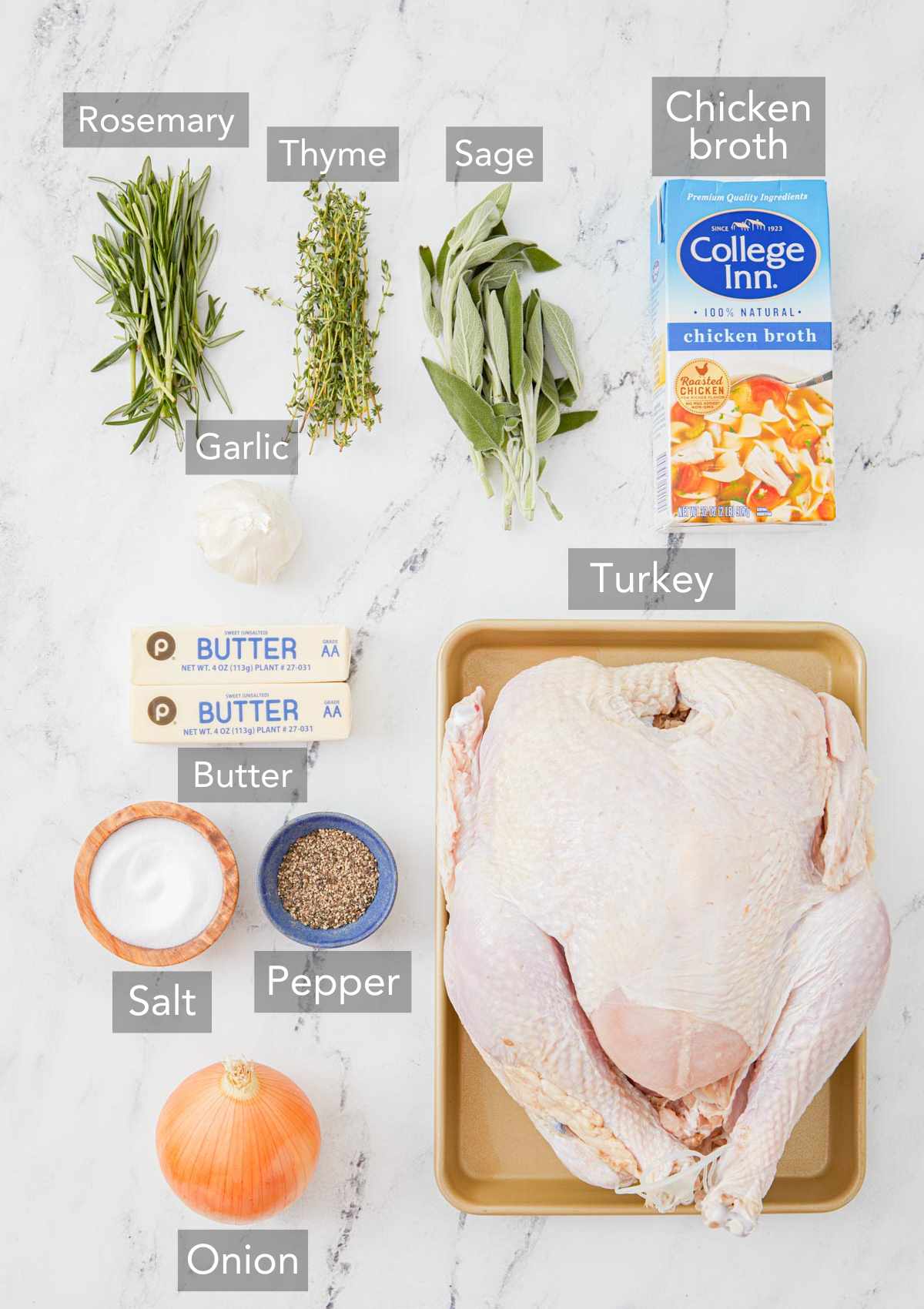
These are the main ingredients you need to make a roasted turkey. You can find the full list of ingredients and measurements in the recipe card below.
Turkey — a fresh or thawed frozen turkey. A fresh turkey that hasn’t been pre-brined is my ideal kind. If you buy a frozen turkey, be sure to allow enough time to properly thaw it before you get started.
Butter — you’ll rub a mixture of softened unsalted butter, salt, and black pepper all over the bird so the skin crisps up and achieves a gorgeous golden brown color.
Herbs — a trio of fresh herbs (rosemary, thyme, and sage) infuse the turkey with earthy flavor and also produce the most delicious drippings, so save them for making gravy!
Aromatics — an entire onion and a head of garlic go into the cavity to season the turkey from the inside during roasting.
Broth — chicken broth helps the turkey remain moist while it roasts and also adds flavor to the drippings. If you don’t have broth, you can use water or white wine.
How Many Pounds Of Turkey Do I Need Per Serving?
Generally, allocate 1 to 1½ pounds of turkey per guest. I lean towards more (1½ pounds per guest) to ensure I have more than enough food for my gathering, plus leftovers! Take the weight of the uncooked whole turkey to calculate the servings and size needed.
Here’s a simple guide you can follow to decide how much your turkey should weigh:
- 8-10 pound turkey: 6 to 10 servings
- 10-12 pound turkey: 8 to 12 servings
- 12-16 pound turkey: 10 to 16 servings
- 16-20 pound turkey: 14 to 20 servings

How To Thaw And Prepare A Turkey Before Roasting
If you buy a frozen turkey, the most important step is to make sure it thaws fully before you prep and roast it; otherwise, it may not cook evenly. Turkeys should always be thawed in a cold environment to keep bacteria from growing.
How Long Does It Take To Thaw A Frozen Turkey?
Allow 24 hours of thawing time in the refrigerator per 5 pounds of turkey. To figure out how many days you need, take the total weight of your turkey and divide it by 5. This number will tell you how many full days you need! Multiply that number by 24 to get the total number of defrosting hours needed to determine your exact timing.
For example, if you have a 15-pound turkey: 15 ÷ 5 = 3 and 3 x 24 = 72 hours. Thus, a 15-pound turkey will take about 72 hours (3 days) to thaw out completely in the refrigerator. If time allows, I like to give myself an extra half or full day to make sure there’s no frozen surprise when I go to prep the bird.
Shortcut thawing method: Soak the packaged turkey in cold water, which you will need to change every 30 minutes. It should take 1 hour per 2 pounds of turkey. To figure out how much time you need, divide the total turkey weight by 2. So, if you have a 15-pound turkey, it should thaw out in about 7.5 hours. If you opt for this method, only use cold water (not warm or hot water). If at any point you can’t change the water regularly, do not leave the turkey out on the counter. Remove it from the water and return it to the fridge to continue thawing.
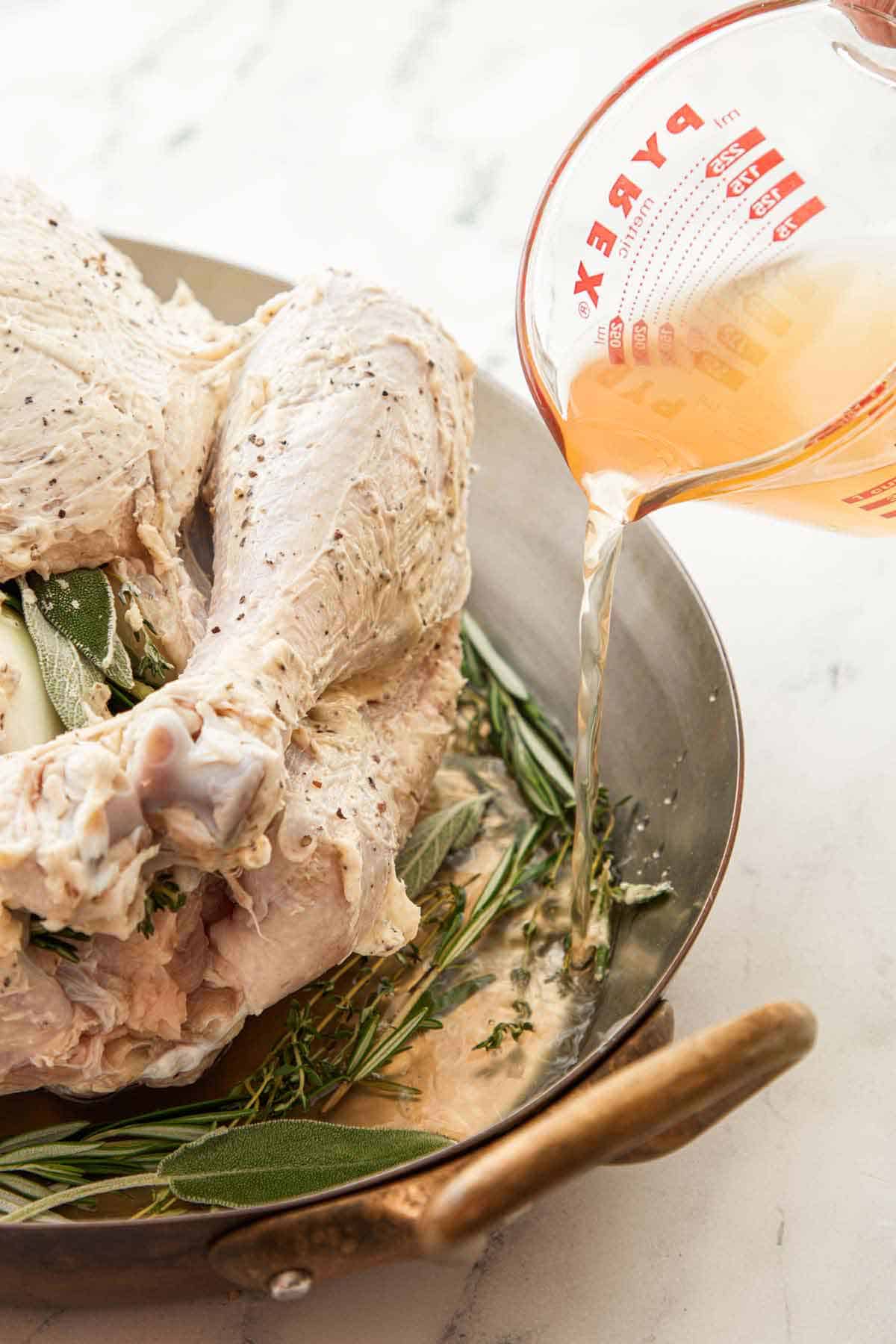
Should I Brine The Turkey?
My roasted turkey recipe will result in a succulent and flavorful bird without brining, so it is not a necessary step, especially if you don’t have the time or fridge space to do so. Some turkeys come pre-brined, so look for that on the label if you’re buying from the grocery store.
A turkey brine— essentially a long soak in a seasoned saltwater bath— can help create a very flavorful and juicy turkey. You can certainly do this if you’d like. Be sure you give enough time for the turkey to thaw before you brine it. You can use this roasting method for a turkey that has been seasoned in a dry brine or wet brine.
Can I Stuff The Turkey?
It’s totally up to you. I do not, but you can put stuffing in the turkey if you wish. Adjust the cooking time to 15 minutes per pound of roasting time (more information in the section below). The stuffing will also need to reach 165°F. Unfortunately, the time it takes for the stuffing to cook completely often takes longer than the turkey itself, and can dry out the meat. For this reason, I recommend cooking it on the side instead.
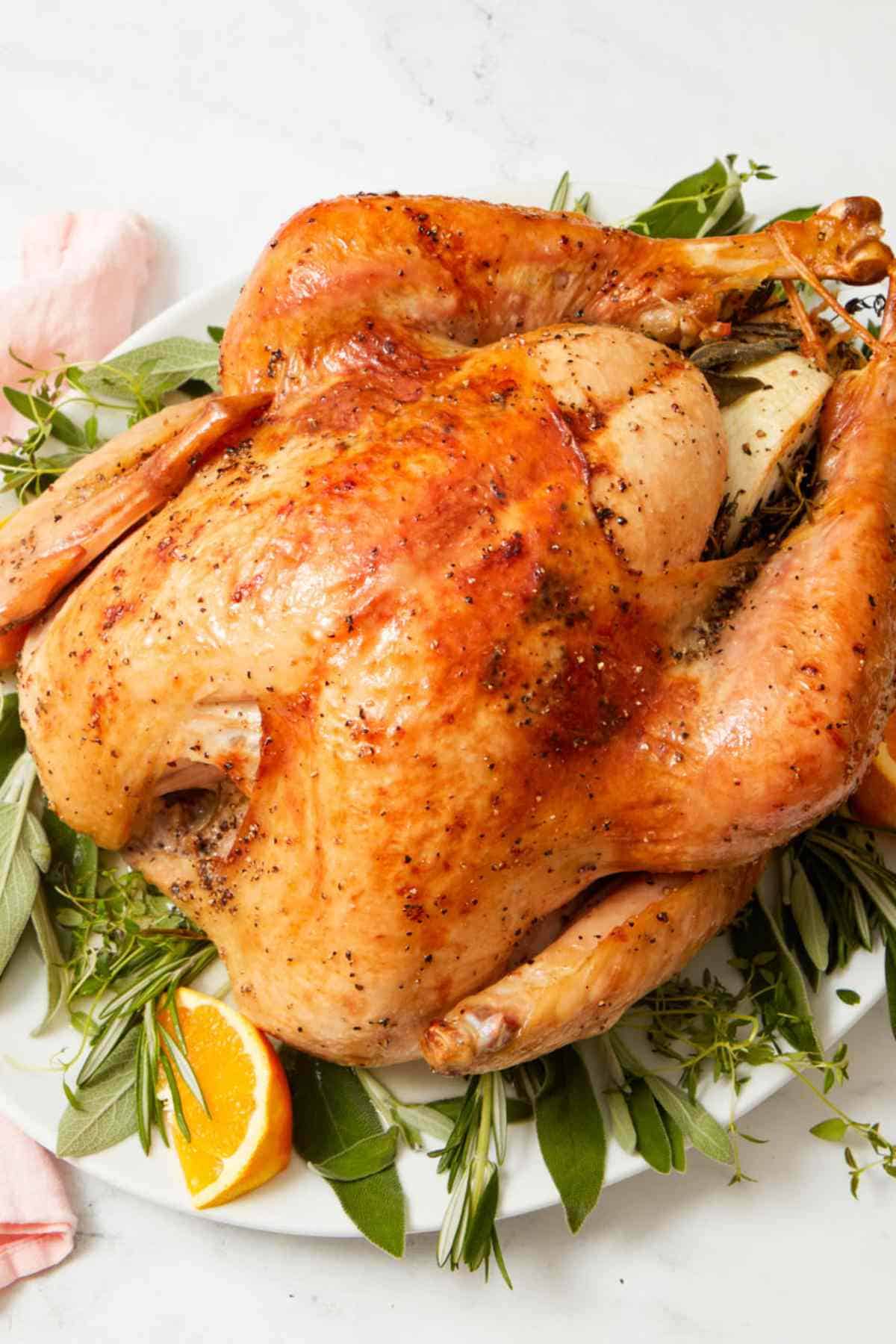
Quick Roasting Guide Based On The Size Of Your Turkey
One of the most common questions readers ask me when learning how to roast a turkey is “How long does it take to cook?” Because everyone buys a different size, it’s more of a formula than one specific time frame.
13 minutes per pound of turkey is the typical time for calculating the roasting time of an unstuffed turkey. Your turkey may cook faster than that, though, so just make sure you start checking the internal temperature about 15 minutes earlier than you think it might be done. Here’s a breakdown of the general cooking times to ensure you roast a perfect Thanksgiving turkey:
- 8-10 pounds: 1:45 – 2:15 hrs
- 11-13 pounds: 2:20 – 2:50 hrs
- 14-16 pounds: 3 – 3:30 hrs
- 17-20 pounds: 3:40 – 4:20 hrs
For a stuffed turkey, add 2 minutes per pound (so 15 minutes total per pound) when filled with a hefty bread stuffing (not simple aromatics). If you need to cook your turkey faster, try my spatchcock turkey!
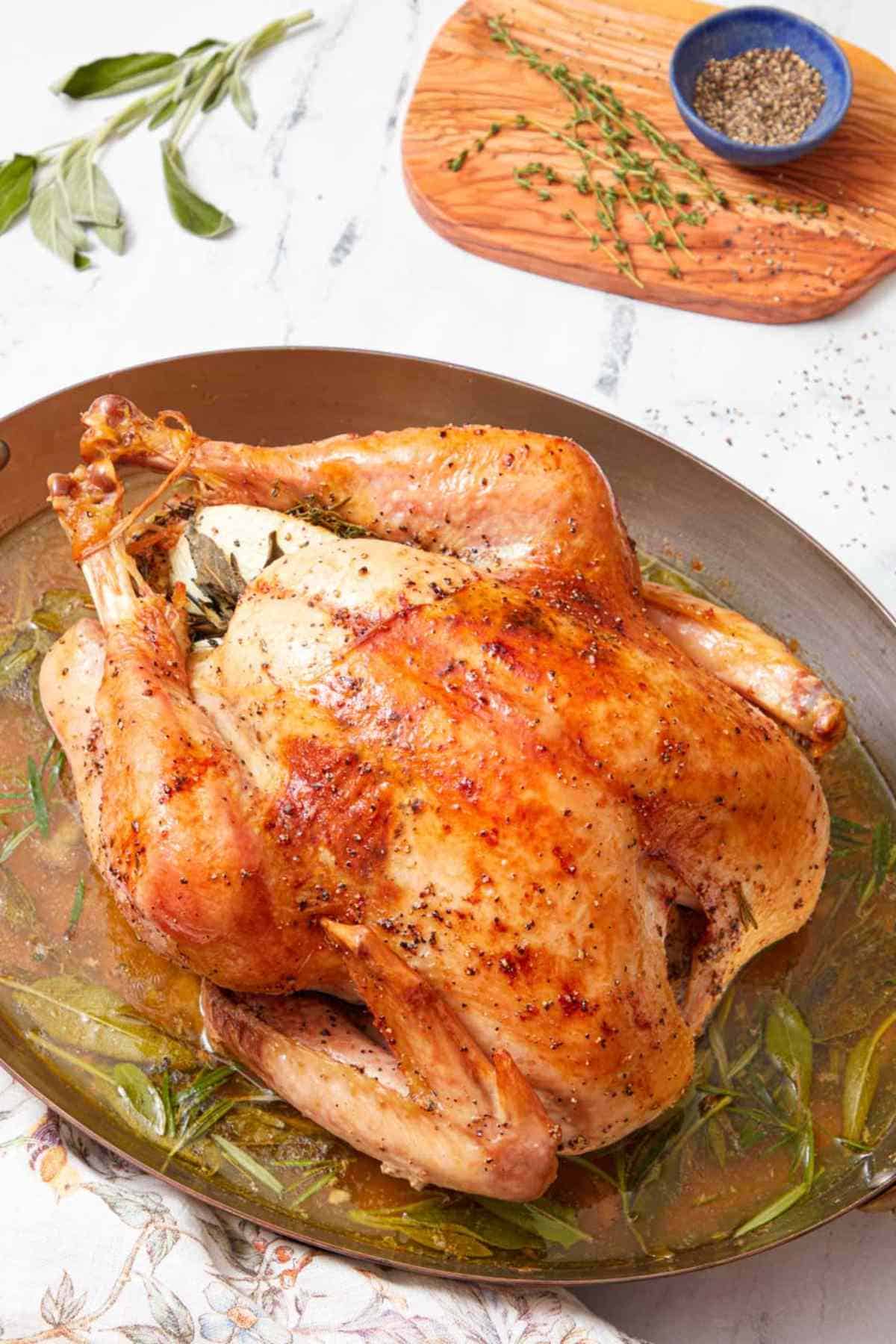
How To Properly Check The Internal Temperature
It is vital to use an instant-read thermometer or meat thermometer to check the internal temperature of your turkey. There’s really no better way to keep an eye on it. If your turkey comes with a pop-up “thermometer,” keep in mind that these can be wildly inaccurate and may cause you to inadvertently overcook the Thanksgiving turkey, and I do not recommend using them to determine if your turkey is done cooking.
Insert the meat thermometer in the thickest part of the turkey, typically where the thigh meets the breast. Do not touch the bone. The turkey is ready to come out of the oven when the thermometer registers an internal temperature of 160°F in the thickest part of the thigh. The temperature will continue to rise as it rests, coming up to 165°F— which, according to the USDA, is the safe minimum internal temperature for turkey.
FAQs To Know Before You Start
No, there is no need to rinse the turkey before preparing it. Rinsing it can actually spread bacteria around your sink and the rest of your kitchen, so I advise against it.
Yes, it’s a good idea to increase the seasoned butter for a larger turkey. For a 14- to 18-pound turkey, increase by 50%. For an even larger turkey, double the amount in the recipe.
While you can use a turkey bag, the turkey skin will not get crispy as the bag traps steam, keeping the skin soft. This roasted turkey recipe produces a perfectly juicy turkey. So as long as you use a meat thermometer to check for doneness, you will not need a turkey bag!

Pro Tips For Roasting The Perfect Turkey
Let the turkey sit at room temperature for 1 hour before roasting. This will air-dry the skin for better browning and a crispier skin.
Use different flavor combinations: The simplicity of the turkey seasoning shouldn’t be underestimated! The butter, salt, pepper, and bunches of aromatics create a wonderfully juicy and flavorful turkey. If you’re feeling more adventurous, use your favorite spice blend or make a homemade turkey seasoning rub, and mix it into the softened butter. Cajun seasoning or a garlicky Greek seasoning are two of my favorites. Have fun with the flavors!
If I plan to make a gravy with the drippings, I like to slice up an onion, a few carrots and celery stalks, and an apple or whole lemon, and place it in the bottom of the roasting pan before adding the turkey. This infuses the pan drippings with even more flavor! Follow my gravy recipe for how to make the perfect one using the drippings.
Start the oven at a high temperature. Starting the turkey at a higher oven temperature essentially “sears” the outside, creating a more crispy golden skin during roasting while also helping to seal in the juices so the turkey stays moist during the long cooking time.
Baste the turkey: Continuously basting the turkey keeps the outside from getting too dry and also helps brown the skin for a moist turkey, so I definitely wouldn’t skip that step! I use a pastry brush dipped in the pan juices to brush over the bird. There is no need for a baster if you don’t have one.
Let the turkey rest for at least 15 minutes before carving. You don’t want to ruin your juicy turkey in the last step by not waiting to slice into it. This is a vital step so the juices in the turkey can redistribute, so that every bite is juicy and moist. If you carve the turkey immediately, the juices will run out onto your cutting board.
How To Roast A Turkey
Below, I’ve highlighted portions of the recipe in step-by-step process images along with instructions for how to make the best Thanksgiving turkey recipe. You can find the full set of instructions in the recipe card below.
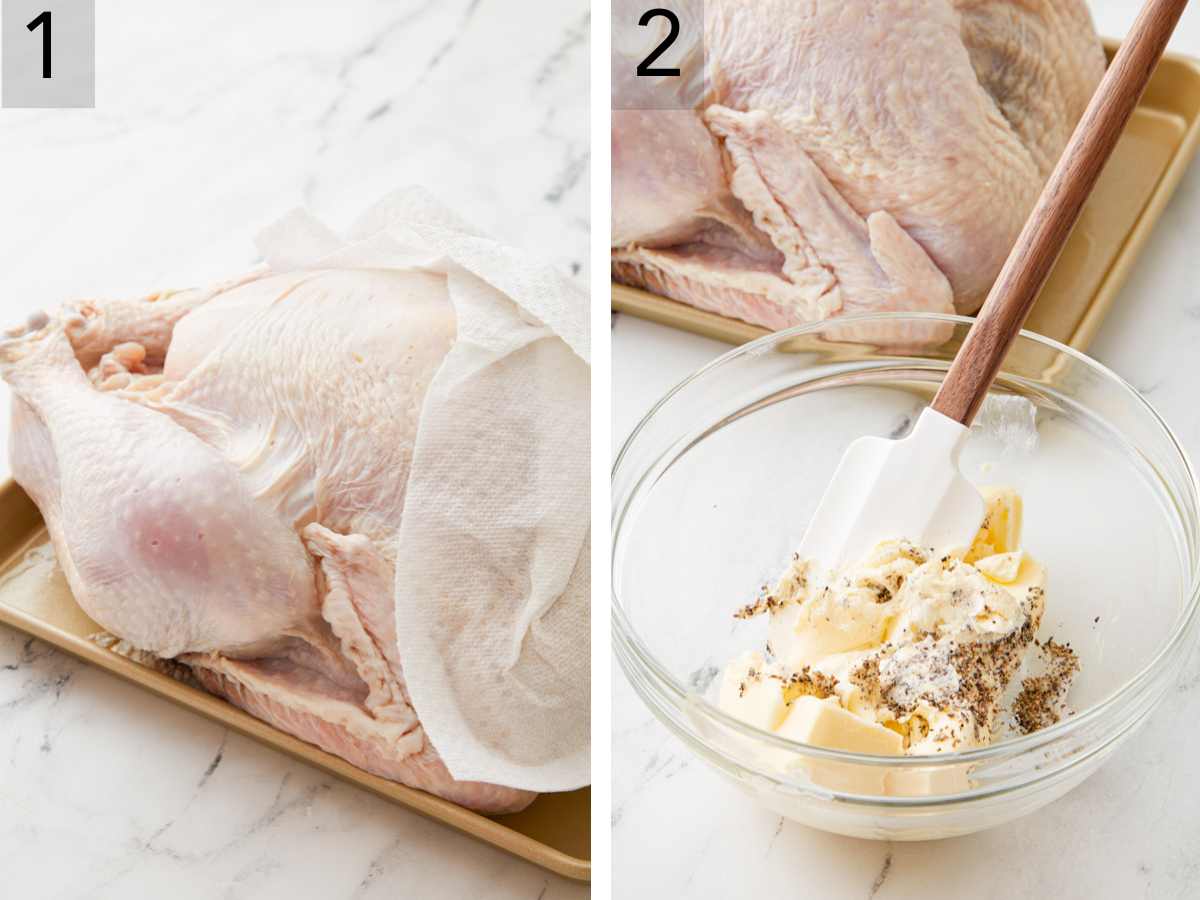
1. Place the thawed turkey, breast side up, in a large roasting pan. (You can use a wire roasting rack inside it if desired.) If you brine your turkey, let it drain well before placing it in the pan. Remove any giblets from the turkey cavity. Pat the bird dry all over with paper towels. Let it sit uncovered at room temperature for 1 hour.
2. In a medium bowl, stir together the butter, salt, and black pepper. Set aside.
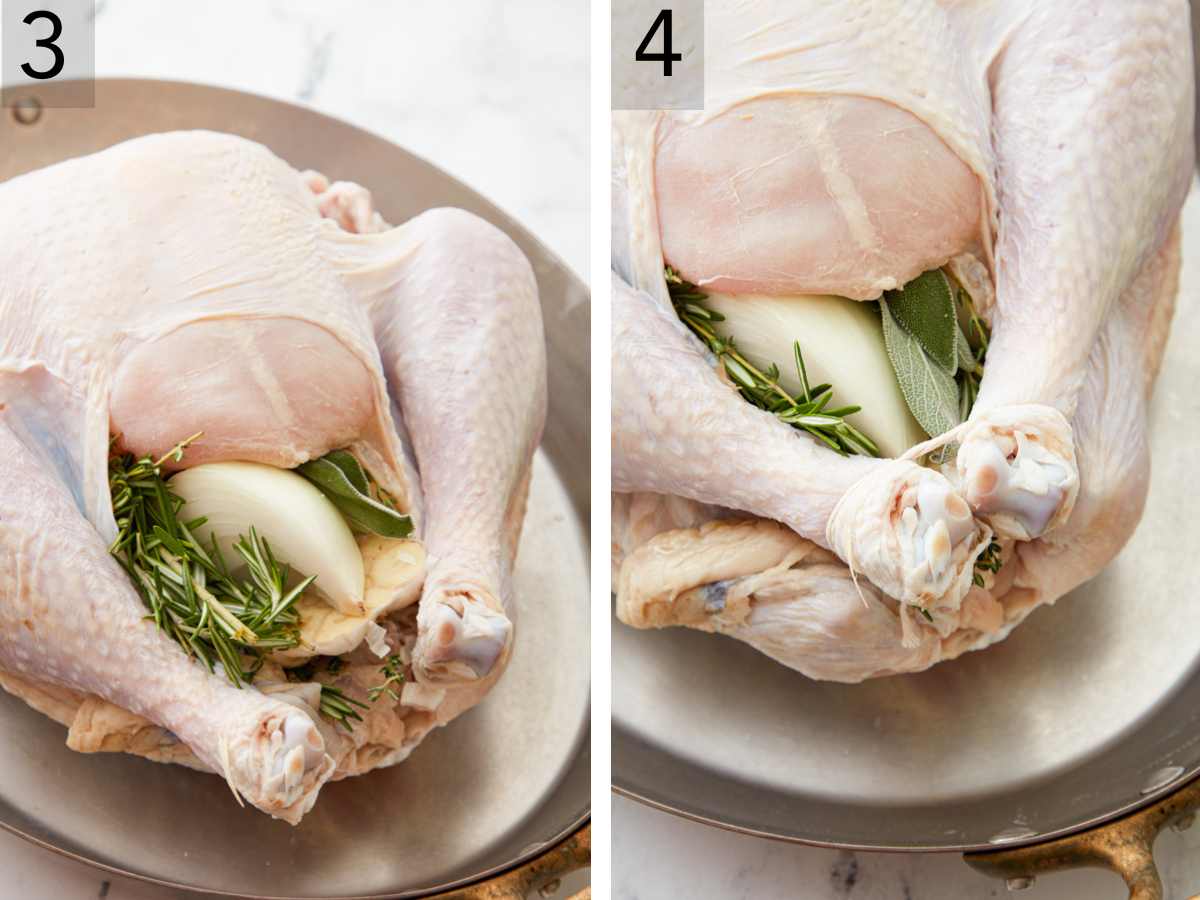
3. Stuff the cavity with onion, garlic, 8 sprigs of rosemary, and 8 sprigs of sage. Place the remaining herbs in the roasting pan around the turkey.
4. Tie the legs together with kitchen twine.
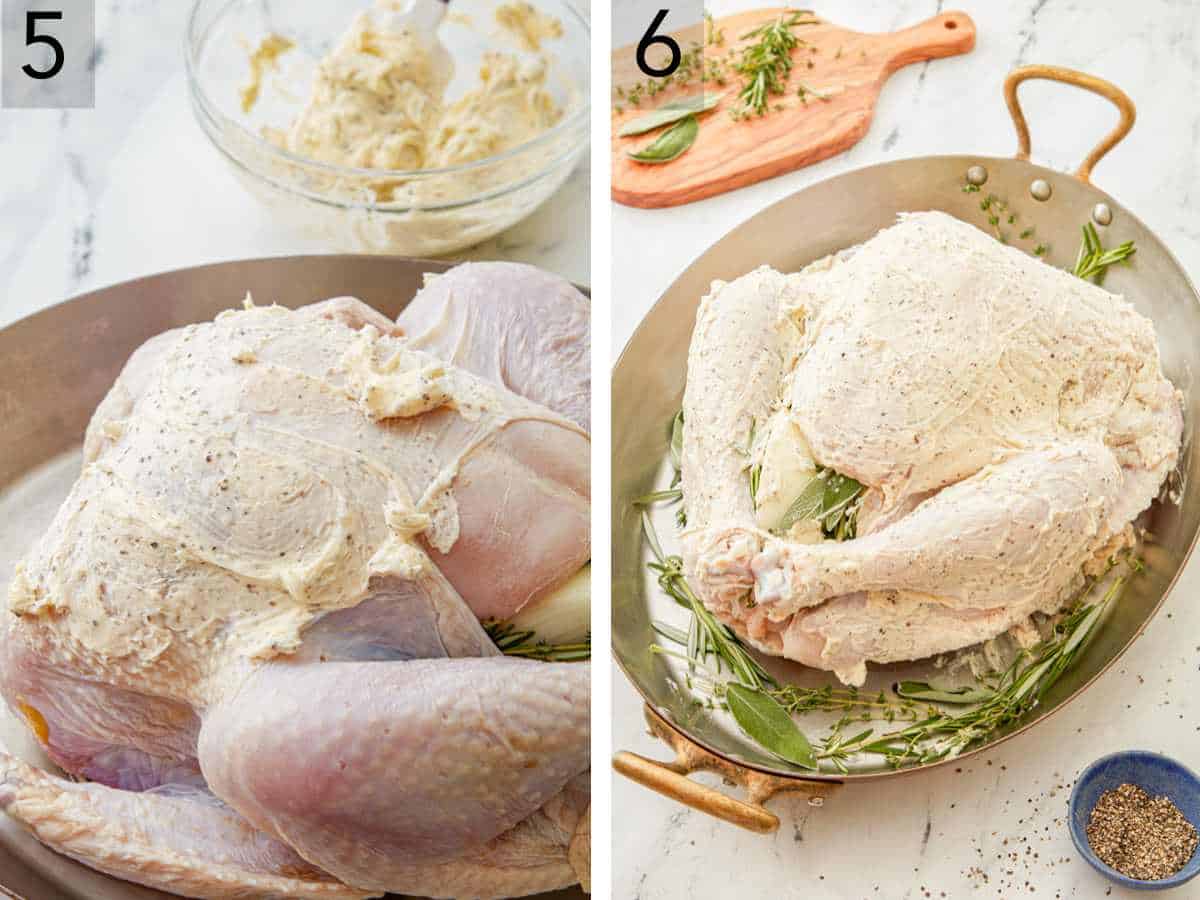
5. Rub the butter mixture all over the turkey, making sure to get under the skin on the breast and legs. Pour the chicken stock into the roasting pan.
6. Roast for 15 minutes at 450°F. Then reduce the oven temperature to 325°F. Continue roasting, basting the turkey every 30 minutes with the pan juices until a meat thermometer inserted into the thickest portion of the thigh registers 165°F. Add more broth or some water to the roasting pan if it starts to dry out at any point. Let the turkey rest in the roasting pan for 15 minutes before carving. Strain the turkey drippings and serve them with the turkey or use them to make a delicious, flavorful gravy.

Roast Turkey Recipe
Video
Equipment
- Roasting pan with rack
- mixing bowl
- Basting or pastry brush
- Aluminum foil (if needed)
Ingredients
- 1 (10-12-pound) fresh turkey thawed if frozen*
- 1 cup unsalted butter room temperature (227g)
- 2 teaspoons salt
- 1½ teaspoons ground black pepper
- 1 onion peeled and quartered
- 10 to 12 rosemary sprigs divided
- 10 to 12 sage sprigs divided
- 10 to 12 thyme sprigs
- 1 head garlic halved
- 4 cups chicken broth (960ml)
Instructions
- Remove all packaging and place the turkey breast side up in a large roasting pan with a wire rack. If brining your turkey, let the turkey drain well before placing it in the pan. Remove any giblets in the turkey cavity. Pat the turkey dry all over with paper towels. Let sit uncovered at room temperature for 1 hour. (This will help dry out the skin for better browning and take the chill off the turkey.)
- After an hour, preheat the oven to 450°F.
- In a medium mixing bowl, stir together the butter, salt, and black pepper.
- Stuff the cavity with the onion, garlic, 8 sprigs of rosemary and 8 sprigs of sage. Place the remaining herb sprigs in the roasting pan around the turkey.
- For better presentation, tie the legs together with kitchen twine.
- Rub the butter mixture all over the turkey, making sure to get under the skin on the breast and legs. Pour the broth into the roasting pan.
- Place the turkey in the oven and roast for 15 minutes. Reduce the oven temperature to 325°F. Continue roasting, basting the turkey every 30 minutes with the pan juices, until a meat thermometer inserted into the thickest portion of the thigh registers 165°F, 2 to 2½ hours or about 12 minutes per pound of turkey. Add more broth or some water to the roasting pan if it starts to dry out at any point. If the breast area or leg or wingtips start to get too brown anytime during cooking, shield just those areas with foil.
- Let the turkey rest in the roasting pan for 15 minutes before carving. Strain the drippings in the roasting pan and serve with the turkey or use it to make a delicious, flavorful gravy.
Notes
- If the breast, leg, or wingtips start to get too brown during cooking, shield just those areas with aluminum foil.
- Don’t skip the rest time! You need at least 15 minutes (30 minutes is more ideal) to let the juice redistribute for a juicy turkey.
- The turkey will hold its heat nicely for up to an hour. Because the turkey is so thick, it won’t cool down very quickly, so you don’t need to time it to be done right when you want to serve your meal. Roast the turkey, let it rest, and finish warming your final side dishes just before serving.
- Once a turkey is carved, it can be reheated at 350°F. Place about ½ cup of chicken or turkey stock on a large sheet tray. Place the pieces of turkey, skin-side up, over top of the stock. Bake for 15 to 30 minutes (depending on how warm or cool the turkey is before reheating) just until warmed through. I like to reheat the pieces whole (ie. the thighs, legs, and breasts intact), then slice.
Nutrition
How To Carve And Serve Roasted Turkey
Be sure to let the turkey rest for at least 15 minutes before you carve into it. This allows time for the meat to relax and the juices to redistribute. If you cut it right out of the oven, those juices will pour out, and the meat will turn dry. Check out my tutorial for How to Carve a Turkey for the exact steps on how to break down the bird— don’t worry, it’s much easier than you think!
You can use the turkey drippings to make a creamy gravy to drizzle over the turkey and side dishes. Serve turkey with any of your favorite classic Thanksgiving side dishes, like mashed potatoes, green bean casserole, classic stuffing or sausage stuffing, cranberry sauce, and candied yams. For more inspiration, have a look at all my side dish recipes!
How To Store And Use Leftovers
Storing: Be sure to refrigerate or freeze roasted turkey within 2 hours of cooking it. According to the CDC, this is the window of time that you can safely avoid food-borne illness. Pack any leftovers in an airtight container and refrigerate for up to 4 days or freeze for up to 3 months.
My favorite leftover turkey meal is a simple turkey sandwich made with sliced turkey, a good cheddar cheese, and a healthy slathering of mayo on slices of potato bread or white bread. You can also save the bones, main carcass, and any trimmings to make homemade turkey stock. If any of your leftover turkey meat is a bit dry, turn it into a turkey pot pie or turkey noodle soup.
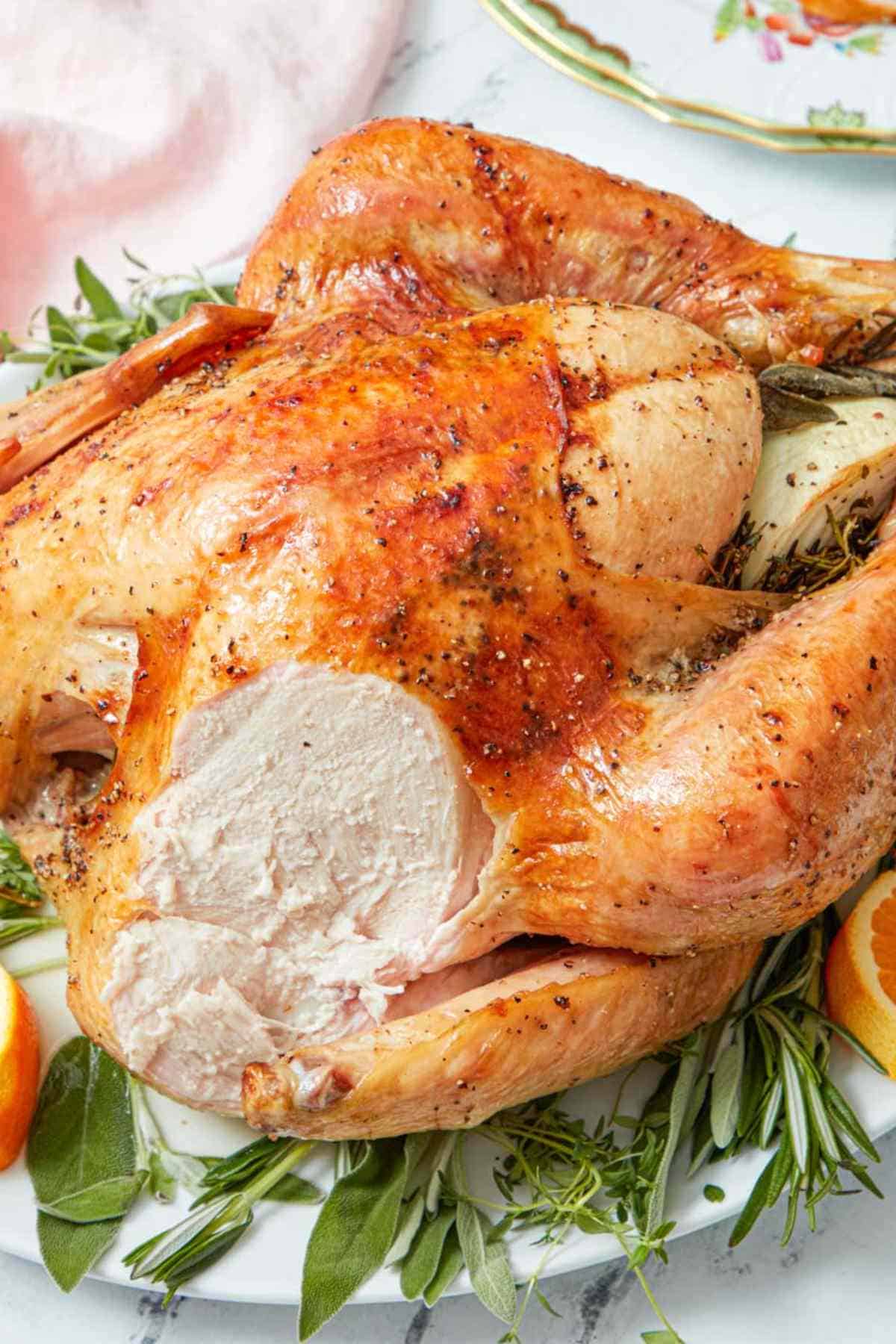
More Thanksgiving Recipes To Try
This roasted turkey is perfect served alongside some of my other traditional Thanksgiving side dishes.
My creamed corn recipe is rich, creamy, and so delicious! Make it with fresh or frozen corn and just a few additional ingredients.
A southern classic, cornbread dressing is an excellent addition to any holiday meal. Make the cornbread a day in advance to help with your prep time and to dry it out a bit.
This sweet potato casserole is always on my Thanksgiving table! It’s super easy to make with mashed sweet potatoes, butter, a couple of seasonings, and the topping of your choice.
Puree butternut squash and turn it into a cream sauce for this decadent butternut mac and cheese! You can use pasta shells or elbow macaroni.
These garlic mashed potatoes are packed with flavor from whole garlic cloves, creamy Yukon gold potatoes, and plenty of butter and sour cream.
If you’ve tried this how to cook a turkey tutorial, then don’t forget to rate it and let me know how you got on in the comments below. I love hearing from you!



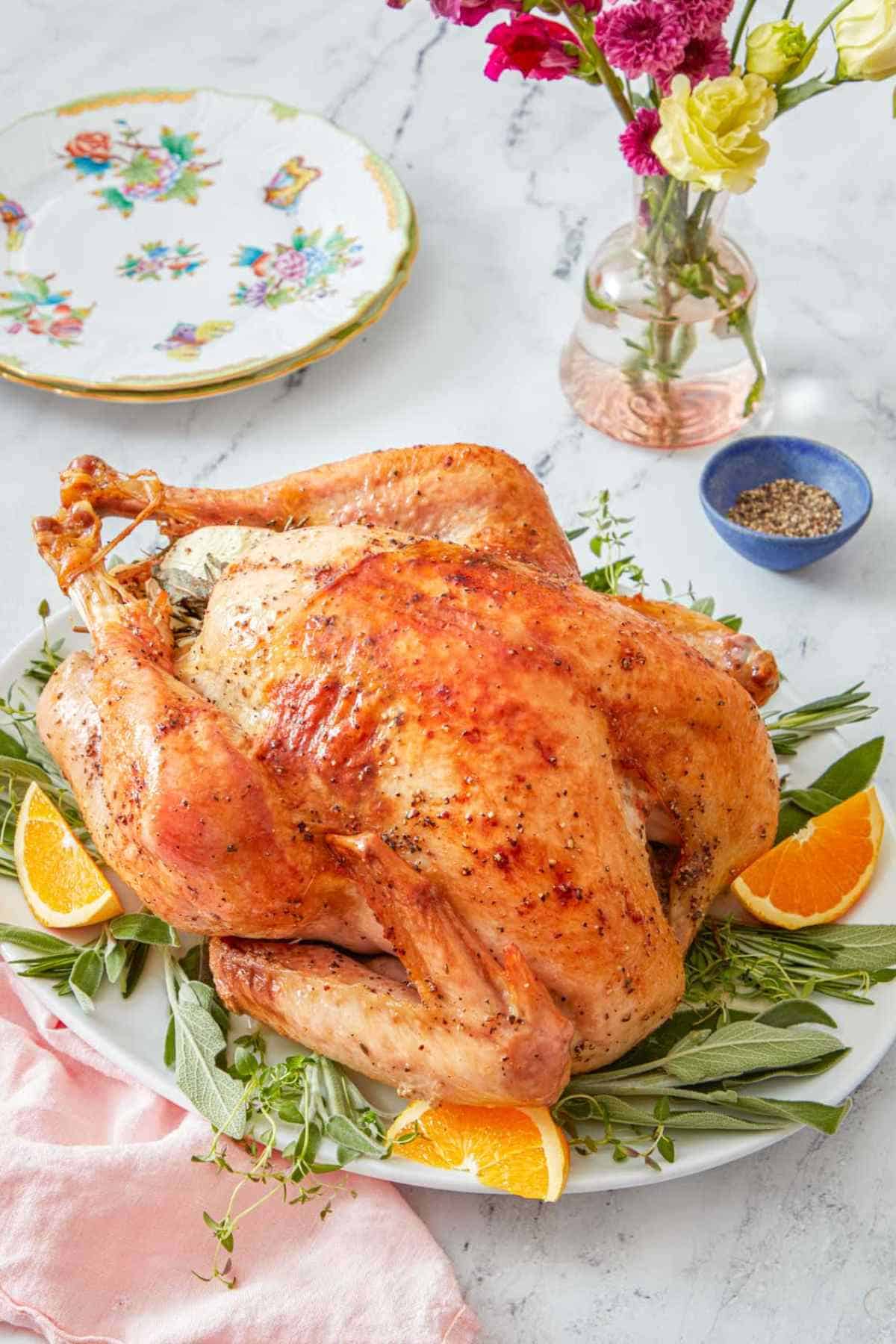
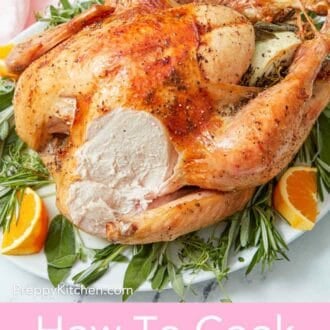
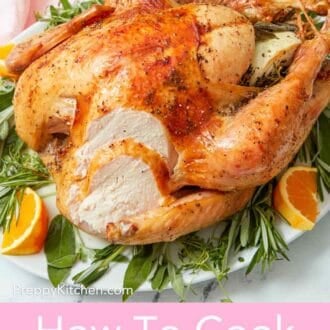
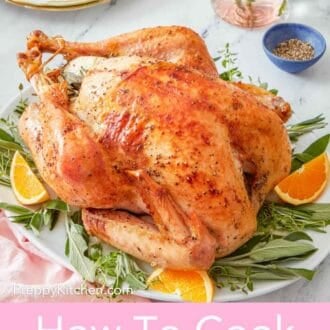

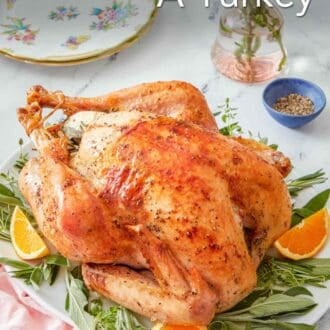
Becky says
This was so helpful for me last year! It’s the first time I ever brined a Turkey. I’m back for the recipe this year!
Sandra Wright says
Last Christmas I cooked Christmas dinner for the second time in my life. I followed the instructions for cooking a turkey and the result was extraordinary. I paired the turkey with your mac & cheese receipe. My brother said “this was worth the wait”. Thank you so much …
Holly says
I love everyone of your recipes. I just can’t get my cheesecake to come out right. 😕
Lori Venerdi says
Made our turkey this way last year and it was fantastic.
First time in 30 years of marriage my husband, who doesn’t really like turkey, said it was really good.
I have a 24 pound turkey this year.
What are the best modifications? Double everything?
Isabella says
Amei a receita chef. Fui encubida de fazer este ano o peru. Sei ,que os americanos são especialistas em assar. Grata,farei! Feliz Natal
Jacqui says
I have always been intimidated when it came to cooking a turkey, usually I would just throw it in one of the baking bags and call it a day, but after 40 years I decided to try this recipe and boy am I glad I did! I followed the directions just as they were written, read all the tips, brined it for 12 hours and baked it according to the way the recipe instructed. It turned out amazing! Everyone loved it! So moist and juicy with a golden brown skin and the best flavor ever! I couldn’t believe that I actually turned out such a beautiful bird! This will be my go to recipe for all the years to come! And I can promise you I will be handing it down to our girls as well! Thank you SO much for sharing and for the explicit and easy instructions! I only wish I would of taken a picture!
Can’t wait to see what you have coming out for 2023! Thank you so so much for giving back!
Ashley says
I made my first Turkey today at the age of 35! This was absolutely delicious and I really can’t thank you enough! I also made the cherry pie and know moving forward I will just have to try as many recipes as you share with us all to catch me up to this domestic world! 🙂 Thank you so much! It was beautiful looking as well!
Deb Stine says
You are such a good teacher! I love reading all your notes because they really help. During Covid I learned how to bake bread, and you taught me how to easily firm them into the right shape and they are perfect every time. You know just what to say to the person who’s not been doing things 100 years! I’ve been cooking a long time but when I try something new, I really appreciate the way you explain things and your videos are great too. I’m really appreciating your site. Have a great Thanksgiving!
Deb Stine says
Sorry- that was supposed to be “form” the rolls into the right shape.